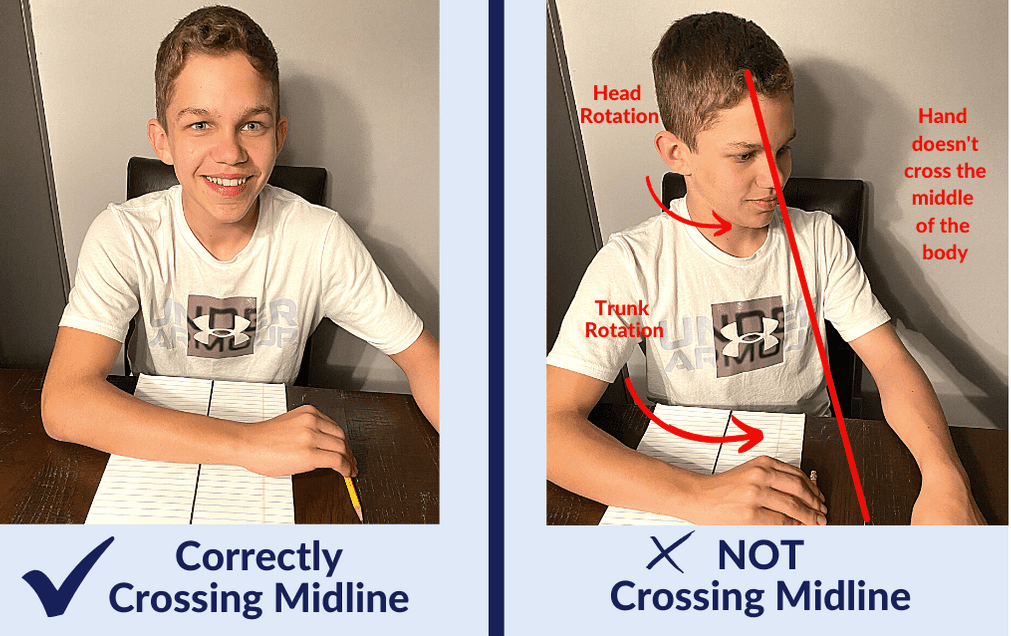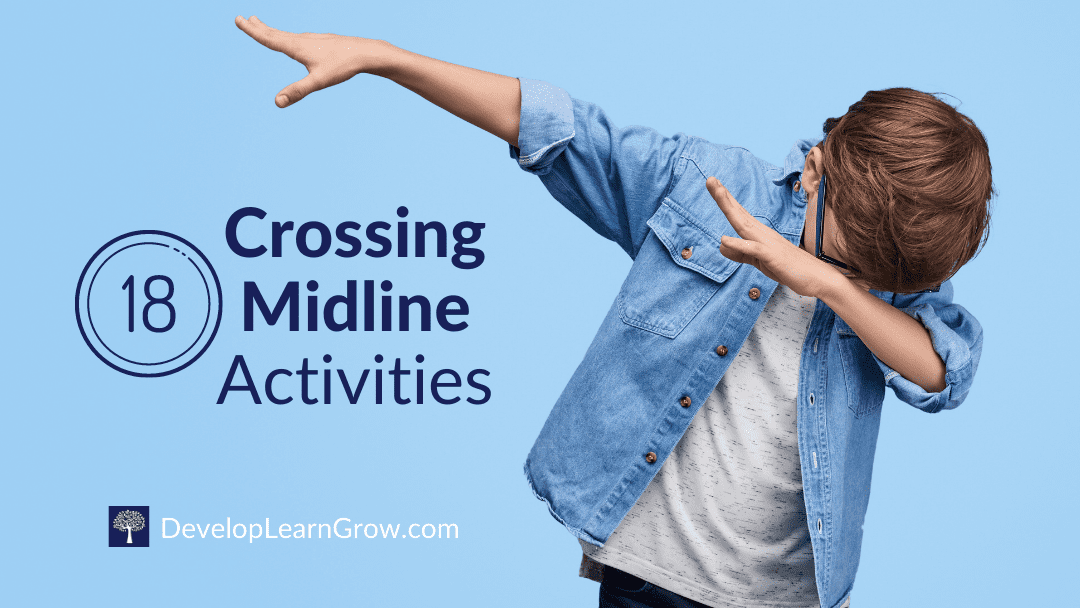These occupational therapy midline crossing activities are quick and easy to use. They’re great for all developing brains, bodies and eyes!
I remember the confusion on my son’s face when I asked why he picked up his pencil with his left hand. He was right-handed.
His response, “Because it was sitting there!” (on the left side)
He picked it up with his left hand and transferred it to his right hand at the middle of his body.
The OT in me thought, “Oh no, he’s not crossing midline! He should have reached across the middle of his body with his right hand to get his pencil!”
Of course, I placed it back down on his left side to have him reach for it again… with his right hand, per mom’s request. I carefully analyzed his body position and arm movements as he grabbed it.
OT-Mom relief… he effectively crossed his midline without rotating his trunk!
He gave me one of those looks, shook his head, and started his homework.
What is Midline Crossing?
Midline crossing, or crossing the midline, is when a person’s arm or leg crosses the middle of the body to the other side.
Picture an imaginary line that goes from the top of the head through the nose, neck, chest, and belly button. This line divides the body into left and right sides.
When a child crosses midline, their hand will reach across this imaginary line to the other side of the body.
The important part to note, is that the trunk stays still – the body does not twist – as the arm reaches across the middle.
You cross your midline when you put on your seatbelt or turn the steering wheel for a sharp turn. Midline crossing is also required when washing your body, putting on lotion, and getting dressed.
For kids, crossing the midline typically starts around age two. This skill continues to develop as they grow.
It’s an important skill needed for completing daily motor tasks and academic tasks.
Crossing midline and bilateral coordination skills help with the efficiency of motor movements. Additionally, they help both sides of the brain communicate for learning.
How Can You Tell If a Child is Having Difficulty Crossing Their Midline?
Some kids have difficulty with midline crossing. They don’t automatically cross the middle of their body smoothly for motor tasks.
You will see them use their right hand on the right side of the body… and their left hand on the left side of the body.
They may pass things from one hand to the other at the center of their body.
Or, it may look like they’re crossing midline, but they actually twist their trunk and/or turn their head. Their core may not be stable. They may have difficulty keeping the head still to move the eyes to either side.
It’s almost as if the dividing imaginary line is a more like a plexiglass panel that blocks the arm from passing the middle of the body.
You will see kids reach with their right arm to the left side – but they twist their body and turn their head. The “glass panel” is blocking the arm from reaching over the middle.
Even if they slightly cross the middle of their trunk with their hand, they may turn and tip their head. They don’t allow the hand to move past their nose.

The eyes also have to cross the midline when visually tracking objects. They need to smoothly move side to side.
When the eyes have difficulty crossing midline, you will see them pause or jump at the middle… as if there’s a bump in the center of them.
This greatly impacts reading skills and visual attention for learning tasks.
Why Are Midline Crossing Activities Important for Kids?
Crossing midline activities encourage communication of the two sides (hemispheres) of the brain. This is VERY important for development and learning!
Midline crossing activities help to make motor movements more efficient. They help with the development of hand dominance and bilateral coordination.
When these motor skills are addressed, kids can effectively manage classroom materials. Tasks such as cutting, getting dressed, and tying shoes are easier and less awkward.
Drawing and writing tasks are easier when kids can automatically cross the midline. They can form letters and numbers properly and write across a page without difficulty.
An inability to cross the midline may cause letter and number reversals as well as difficulties writing left to right. The two sides of the brain need to communicate effectively for writing.
Crossing midline activities help eye movements needed for learning tasks such as reading. They help the eyes smoothly move back and forth across text.
In summary, midline crossing activities are essential for the developing brains and bodies of all kids. They’re especially beneficial for kids who have motor or learning difficulties.
18 Quick Midline Crossing Activities for Academic Tasks
The activities are divided into two sections: quick exercises / games and YouTube Videos. The exercises and games can be plugged into any part of your day. In between lessons, when kids need a quick brain break, etc.
The YouTube videos are fun if you’d like someone else leading a classroom brain break!
Quick Brain Break Exercises
#1 Arm Scissors
Students can sit or stand for this exercise. Tell them to hold arms straight out to the sides. Keep arms straight as they cross them in front of their body. Return the arms out to the sides.
Encourage them to alternate which arm goes on top. For example, right arm crosses over left arm. Arms return to the sides. Then, left arm crosses over right arm.
Have them count as they scissor their arms in front of their body.
#2 Infinity Loop

This is great for the arms and the eyes to cross midline. Make sure kids keep their bodies still and only move their arms.
Start at the center – move up and around to the left –> continuing around & back to the center –> continuing up to the right –> back around to the center –> continuing up to the left and around to the center –> up to the right and around to the center…
For more infinity loop activity ideas, check out Visual Tracking Activities Using Flashcards and the Infinity Loop.
#3 Windmills
Kids stand tall with legs wider than shoulder width. Hold arms straight out to the sides. Bend at the waste to touch opposite hand to the opposite foot. Repeat other side.
Complete as many repetitions as desired. This exercise is also a great movement (vestibular) activity to wake up the brain.
#4 Firecracker
Kids can sit or stand for this. They press their hands together in front of their bellies (fingertips straight.)
Hands stay together and move in front of the body in a smooth side to side position. As the hands are winding side to side, they’re also winding upward above the head.
When they wind above the head as far as they can reach, kids clap hands loudly (firework explosion.) Then, they wiggle the fingers down to make the “sparkles.”
It’s fun to add a whistling sound to this exercise. (Why not add an oral sensory component!) I like to make a whistle that gradually gets louder as the “bottle rocket” is winding upward.
#5 Paddle Board
Kids can sit or stand for this. They clasp hands together (fingers folded in front of them) and pretend they’re holding onto a paddle.
They paddle side to side. Add a song or a chant.
#6 Pass the Ball in a Line
Have kids stand arms width apart. Encourage them to square up to the front of the room and to keep their legs, head, and body still.
Using a gym ball, they reach with both hands to the left to grab the ball and pass it in front of them to the person on their right.
Try more than one ball. You can also use balloons or beach balls. (A combination of different sizes and weights would be an added motor challenge for force modulation.)
If this set-up won’t work to use as a group activity, try having them mimic the movement at their desk. They can sit like a statue and pick up an object with both hands (block, pencils, eraser, etc.) They move the objects from the left side of their desk and move it to the right side.
Then, repeat the activity and pass it all back to the left.
#7 Partner Ball Pass
Have two kids stand or sit back to back. They pass the ball using two hands, from left to right for several rounds. Then, have them switch and pass right to left. Use the same number in each direction to keep it equal.
Again, make sure their bodies and heads are still and they’re just reaching with their arms.
#8 Simon Says
Play Simons Says or have kids imitate different body movements. You can lead, or choose the helper of the week to lead the exercise.
You can also work on auditory skills and following directions. Give several series of directions, such as:
“Touch your right hand to your left ear.”
“Tap your left hand to your right foot, three times.”
#9 Dance Moves
If you’re feeling spontaneous and creative – show some dance moves that cross the midline! Or, have a student come up with their own moves that require midline crossing!
Some examples: teach your kids the Macarena, the Hustle (classic 70’s moves!), or do the “dab”!
#10 Cleaning Up and Wiping Surfaces
When your students need to wipe their desks, they can focus on crossing midline! If a kiddo is right handed, I will sometimes cue them to hold onto the right corner of the desk with their left hand as their right hand does all the wiping. This way, they have to cross the middle of the body without rotating the trunk.
Other surfaces to clean: chalkboards, whiteboards, large windows, doors, etc

YouTube Videos for Midline Crossing
#11 Jack Hartmann’s Crossover | Brain Breaks | Crossing the Midline (3:05)
Upbeat music, song, and demonstration that gets the arms crossing midline.
#12 Yoga for Kids – Children’s Yoga – Brain Breaks – Kids Songs by the Learning Station (3:59)
A lady and boy demonstrate the exercises with song / music. The movements in this video have the arms and legs cross midline.
#13 Minidisco Chocolat | Team4Animation (3:21)
Two ladies dance to a fast, upbeat song.
#14 Crossing the Midline: Heel Touches (1:30)
This one is shorter and has more relaxing music. The lady’s voice is soft and calming! Perfect if you want your kiddos to wind down as they take a break!
**These last four videos are from Minute Moves. They each contain quick dance move tutorials (by Kiki) followed by music and dancing.
They were created for dancing at home, but they’re quick ones for school! Why not add a little hip-hop into your day!
#15 The GRAPEVINE (1:49)
This is a great one to get the feet crossing midline! I love the grapevine for kids!
#16 The Kool Moe Dee (1:00)
The arms cross midline in a “dab” position with side to side stepping.
#17 The Cabbage Patch (1:39)
The arms circle across the middle of the body. More footwork is required (but the feet don’t cross midline.)
#18 The Bart Simpson (1:46)
This move is a little more complicated for kids, if they’re up for the challenge! Legs step side to side and the arms cross in a “dabbing” position!
Enjoy the exercises and videos. Bookmark this post so it’s easy for you to find when you’re planning your brain breaks. Also, share it on your favorite social media platform with friends and/or co-workers. It will help more kiddos!
For related content, check out the posts in the Sensory Activities-Brain Breaks section.
Classroom Exercise Breaks – Crossing Midline Activities, Proprioceptive / Movement Exercises to Increase Focus & Attention, Improve Core Stability, & More…
Use these specific occupational therapy exercises to improve:
Attention… focus… core stability… crossing midline… sensory processing… visual development… & more… Click for more info!




0 Comments